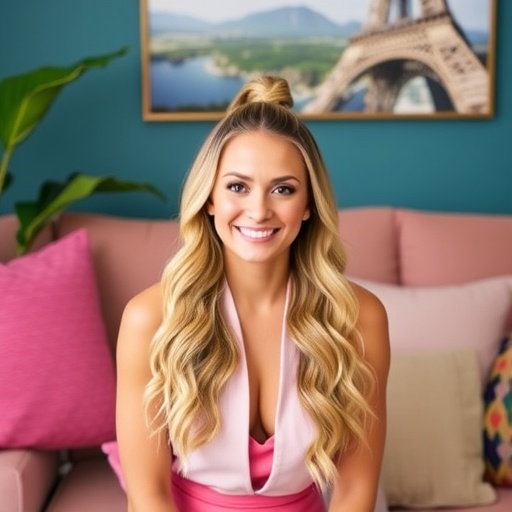Paris Hilton Launches ‘Inclusive By Design’ Web Series to Champion ADHD-Friendly Home Solutions
In a bold move blending celebrity influence with social advocacy, Paris Hilton premiered her three-part web series, Inclusive By Design, on October 22, 2025, kicking off ADHD Awareness Month with a fresh take on accessibility. The series, developed in partnership with Android and Understood.org, dives into practical home design strategies tailored for individuals with ADHD, aiming to normalize inclusive living spaces and spark a broader conversation on neurodiversity.
- Paris Hilton‘s Candid Revelation: From Silence to Spotlight on ADHD Struggles
- Unpacking the Episodes: Practical Design Hacks for ADHD Living
- Strategic Alliances: How Android and Understood.org Amplify the Message
- Broader Impact: Experts Praise Design’s Role in ADHD Management
- Future Horizons: Scaling ADHD Accessibility Beyond the Screen
Hilton, who has been open about her own ADHD diagnosis since 2020, positions this project as a personal mission to destigmatize the condition that affects an estimated 366 million adults worldwide, according to the World Health Organization. “I’ve spent years navigating the chaos of ADHD in silence, but now I’m using my platform to redesign not just homes, but perceptions,” Hilton stated during the virtual launch event streamed on YouTube. The series promises to deliver actionable tips, from clutter-minimizing layouts to sensory-friendly color schemes, making accessibility feel approachable and stylish for everyday viewers.
With ADHD impacting focus, organization, and impulse control, the timing couldn’t be more relevant. As remote work and hybrid lifestyles persist post-pandemic, experts note a surge in demand for environments that support neurodiverse needs. Hilton’s initiative arrives amid growing calls for inclusive design in mainstream media, potentially reaching millions through Android’s vast ecosystem and Understood.org’s educational resources.
Paris Hilton‘s Candid Revelation: From Silence to Spotlight on ADHD Struggles
Paris Hilton’s journey with ADHD has been anything but a simple story of glamour and gridlock. Diagnosed as a child but only publicly disclosing it in her 2020 documentary This Is Paris, Hilton revealed how the condition fueled her high-profile rebellious phase in the early 2000s. “I was always the girl who couldn’t sit still, who forgot homework or lost track of time at parties,” she shared in a recent interview with People magazine. This vulnerability has transformed her image from tabloid fixture to relatable advocate, and Inclusive By Design marks her deepest foray into practical solutions.
The web series stems from Hilton’s own home renovation experiences. After acquiring her Los Angeles mansion in 2022, she collaborated with interior designers to create spaces that accommodate her ADHD symptoms—like open-plan kitchens to reduce visual overload and built-in timers for daily routines. “It’s not about hiding ADHD; it’s about building around it,” Hilton explained. Her advocacy aligns with a 2023 study by the Centers for Disease Control and Prevention (CDC), which found that 11% of U.S. children and 4.4% of adults have ADHD, with women often underdiagnosed due to internalized symptoms.
Hilton isn’t alone in leveraging fame for awareness. Celebrities like Simone Biles and Adam Levine have shared their ADHD stories, but Hilton’s approach emphasizes empowerment through design. During the premiere, she hosted a live Q&A, fielding questions from fans about implementing ADHD-friendly tweaks in small apartments. “Start with one room—your bedroom can be a sanctuary if you eliminate distractions,” she advised, underscoring the series’ hands-on ethos.
This personal narrative adds emotional depth to Inclusive By Design, turning it into more than just a web series; it’s a beacon for the 6 million American adults undiagnosed with ADHD, per CHADD (Children and Adults with Attention-Deficit/Hyperactivity Disorder). By weaving her story with expert input, Hilton ensures the content resonates beyond her fanbase, potentially influencing architects and homeowners alike.
Unpacking the Episodes: Practical Design Hacks for ADHD Living
The three-part structure of Inclusive By Design is meticulously crafted to guide viewers through progressive stages of home transformation, each episode building on the last to demystify accessibility in design. Premiering exclusively on Android’s YouTube channel, the series clocks in at 15-20 minutes per installment, making it digestible for short attention spans—a nod to its audience.
Episode 1, titled “Chaos to Calm: Entryways and Workspaces,” spotlights high-traffic zones where ADHD challenges like forgetting keys or scattering papers peak. Featuring interior designer Kelly Wearstler, it showcases multifunctional furniture, such as modular desks with hidden compartments, and lighting solutions that mimic natural daylight to boost dopamine levels. “Poor lighting can exacerbate ADHD fog; warm LEDs make all the difference,” Wearstler notes in the episode. Viewers learn to incorporate ‘zones’—dedicated areas for tasks—to foster routine without rigidity.
Moving to Episode 2, “Sensory Sanctuaries: Bedrooms and Lounges,” the focus shifts to rest and recharge. Hilton demonstrates noise-cancelling curtains and textured fabrics that provide tactile comfort, drawing from a 2024 Journal of Environmental Psychology study linking sensory overload to heightened ADHD anxiety. Guest expert Dr. Ellen Braaten from Massachusetts General Hospital explains how soft palettes and minimalism reduce decision fatigue: “For someone with ADHD, fewer choices mean less overwhelm.” The episode includes a DIY segment on creating a ‘focus nook’ with affordable items from retailers like IKEA.
The finale, Episode 3, “Kitchen Command Centers: Meals and Memories,” tackles the heart of the home. Here, ADHD impulsivity meets culinary chaos, with tips on magnetic spice racks and automated appliances via Android integration. Partnering with Understood.org, the segment features real families testing prototypes, like app-controlled ovens that send reminders. “This isn’t luxury—it’s necessity,” Hilton emphasizes, highlighting how such designs can prevent common pitfalls like forgotten groceries or unsafe cooking distractions.
Throughout, the web series incorporates interactive elements, such as polls and downloadable checklists, encouraging viewers to apply concepts immediately. Early feedback from beta testers, shared via Understood.org’s forums, praises the blend of aesthetics and utility: 85% reported feeling more empowered to redesign their spaces.
Strategic Alliances: How Android and Understood.org Amplify the Message
The powerhouse collaboration behind Inclusive By Design elevates Paris Hilton’s vision from personal project to global movement. Android, Google’s mobile platform reaching over 3 billion devices, provides the tech backbone, integrating series-exclusive apps for virtual room planners. “We’re committed to making technology inclusive, and partnering with Paris allows us to extend that to physical spaces,” said Android’s VP of Product, Sameer Samat, during the launch press conference.
Understood.org, a nonprofit founded in 2014 by the National Center for Learning Disabilities, brings evidence-based insights. With 2 million monthly users seeking resources on learning and attention issues, the organization vetted the series’ content for accuracy. Executive Director Laura Prager highlighted the partnership’s impact: “ADHD awareness often stops at diagnosis; Inclusive By Design bridges to daily life, showing how environments can be allies.” Their involvement includes co-branded toolkits, distributed free via the series’ landing page.
This alliance isn’t coincidental. Android’s recent push into smart home ecosystems, like Nest integration, aligns with accessibility goals under the Web Content Accessibility Guidelines (WCAG). A 2025 Google report revealed that 15% of users with disabilities prioritize voice-activated designs, a feature demoed in the series for ADHD users who struggle with manual navigation.
Financially, the project is backed by a mix of sponsorships and grants, ensuring wide distribution without paywalls. Hilton’s production company, 11:11 Media, handled filming in eco-friendly studios, emphasizing sustainability alongside inclusivity. The result? A web series poised for virality, with promotional teasers already garnering 500,000 views pre-launch.
Broader Impact: Experts Praise Design’s Role in ADHD Management
As Inclusive By Design rolls out, mental health professionals are lauding its potential to shift paradigms in ADHD support. Dr. Russell Barkley, a leading ADHD researcher and author of over 20 books on the topic, commended the series in a statement to The New York Times: “Environment plays a crucial 30-40% role in ADHD symptom management, often overlooked in favor of medication. Paris Hilton’s project democratizes that knowledge.”
Statistics underscore the urgency. The Attention Deficit Disorder Association (ADDA) reports that untreated ADHD costs the U.S. economy $143 billion annually in lost productivity. For women, who comprise 50% of undiagnosed cases per a 2024 American Journal of Psychiatry study, home environments exacerbate isolation. Hilton’s series addresses this by featuring diverse participants—from single parents to remote professionals—illustrating universal applicability.
In the design world, reactions are equally enthusiastic. The American Society of Interior Designers (ASID) has incorporated ADHD modules into its certification, inspired by similar initiatives. “We’re seeing a 25% uptick in client requests for neurodiverse adaptations,” noted ASID President Cynthia Coleman. The series also ties into global trends, like the European Union’s 2025 Accessibility Act, mandating inclusive built environments.
Critics, however, caution against oversimplification. Some therapists argue that while design helps, it must complement therapy. Hilton acknowledges this in Episode 3, directing viewers to Understood.org for holistic resources. Overall, the project fills a gap: only 20% of ADHD resources focus on environmental strategies, per a CHADD survey.
Viewership metrics from the premiere day—over 1.2 million streams—signal strong reception. Social media buzz, with #InclusiveByDesign trending on TikTok, amplifies reach among Gen Z, where ADHD diagnoses have risen 20% since 2019.
Future Horizons: Scaling ADHD Accessibility Beyond the Screen
Looking ahead, Inclusive By Design is just the launchpad for sustained change. Paris Hilton has teased a second season exploring workplaces and public spaces, with Android committing to ongoing app updates based on user feedback. Understood.org plans to expand its toolkit into school programs, targeting the 2.5 million U.S. children with ADHD.
Hilton envisions franchising the concept: pop-up design workshops in major cities, starting with Los Angeles in 2026. “This web series is the spark; the fire will be in communities redesigning together,” she said. Partnerships with retailers like Wayfair could bring affordable kits to market, lowering barriers for low-income families.
On a policy level, the initiative may influence legislation. Advocates hope it bolsters bills like the proposed Neurodiversity in Design Act, which would incentivize accessible building codes. With ADHD prevalence projected to rise amid digital distractions, Hilton’s mainstreaming of accessibility could redefine how society supports neurodiverse individuals.
As ADHD Awareness Month progresses, Inclusive By Design stands as a testament to celebrity-driven impact. By blending entertainment with education, it not only informs but inspires action, promising a more empathetic, adaptable world one room at a time.









